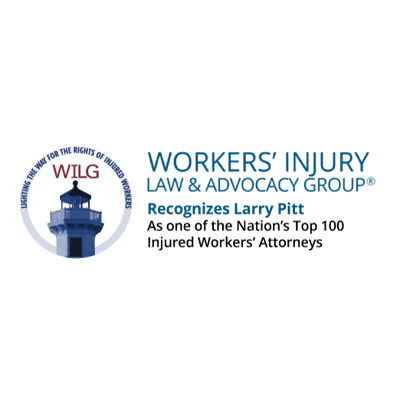Types of Workplace Accidents
Providing Experienced Representation for Injured Workers
Most workplace injuries and occupational illnesses are covered by the Pennsylvania Workers’ Compensation Act. If you sustained an on-the-job injury or contracted an illness at work, you may be entitled to benefits that include reimbursement for your medical bills and lost wages. Determining the cause of the accident is important to ensuring you receive the full compensation to which you are entitled. The legal team at Larry Pitt & Associates, P.C. has represented workers injured in all types of workplace accidents, including:
- Aviation accidents: Baggage handlers, catering crews, ground crews, gate crews, belt loaders, refueling truck drivers, and flight attendants all face risks of sustaining workplace injuries.
- Building collapse: Buildings may collapse due to negligent building design, foundation defects, inadequate building materials, or excessive weight on the structure.
- Caught in/between objects: One of the Occupational Safety and Health Administration’s (OSHA) Fatal Four, this type of accident occurs when a worker becomes caught in or between objects or part of an object.
- Chemical plant accidents: Those who work in chemical plants have dangerous jobs that may expose them to harmful chemicals and other workplace hazards that can lead to serious injuries and illnesses.
- Construction accidents: According to the Bureau of Labor Statistics (BLS), approximately 150,000 workers are injured on construction sites each year.
- Crane accidents: Defects in crane equipment as well as failure to follow proper safety protocol can lead to serious accidents resulting in major property damage, catastrophic injuries, and loss of life.
- Conveyor belt accidents: Due to their moving parts and machinery, conveyor belts pose a risk of injury to many professions, including construction workers, dock workers, airline workers, and factory workers.
- Defective tool accidents: When workers are using tools that are defective or not properly maintained, serious injuries can occur.
- Electrocution: Electricians and other tradespeople are at risk of electrical shock or electrocution when power lines, wiring, and cords are exposed, or when they meet faulty electrical sockets.
- Elevator accidents: Elevator and escalator accidents can occur due to faulty wiring, door malfunctions, and inadequate maintenance or repair.
- Explosions: Workers in the construction, oil and gas, manufacturing, and mining industries are all at risk of being injured in an explosion caused by combustible dust, electrical hazards, improperly maintained equipment, or improperly stored flammable liquids and gases.
- Falls from heights: Another one of OSHA’s Fatal Four, falls are the leading cause of construction fatalities, claiming more than 200 construction worker lives each year.
- Fatal work accidents: When a workplace accident results in a worker’s death, family members may be entitled to workers’ compensation death benefits, which help pay for funeral expenses as well as supplement a portion of the deceased worker’s wages.
- Forklifts accidents: Forklifts are common in warehouses, factories, retail stores, and construction sites. Like other pieces of heavy equipment, forklifts should be operated with extreme caution and only by properly trained personnel.
- Hit by falling objects: Many workers suffer severe head injuries when they are struck by unsecured objects in the workplace.
- Industrial plant accidents: Chemical leaks, explosions, and fires are common causes of industrial plant accidents, which can cause injuries ranging in severity from burns to blindness.
- Kitchen accidents: Restaurant and other types of kitchen workers deal with a number of serious hazards, including sharp knives and other cutting utensils, slippery floors, and hot stovetops.
- Ladder accidents: Workers in many industries that include construction, farming, manufacturing, cleaning, and even office settings may suffer injuries from ladder accidents.
- Machine entanglement: When a worker is pulled in between moving parts of machinery, it can result in serious injuries, such as crushed limbs, degloving injuries, and amputations.
- Manufacturing accidents: Workers in the manufacturing industry face unique risks associated with large equipment, heavy machinery, and dangerous chemicals.
- Healthcare accidents: Workers in the healthcare industry are most at risk for needle stick injuries, which can transmit infectious diseases and blood-borne viruses.
- Power tool accidents: Electric, hydraulic, liquid fuel, pneumatic, and power actuated tools, as well as portable abrasive wheels carry a serious risk of injury if defective or used improperly.
- Railroad Accidents: Workers’ compensation laws do not apply to railroad workers who are injured on the job. Claims must be filed under the Federal Employers’ Liability Act (FELA), which requires the injured worker to prove negligence was the cause of his or her injury.
- Repetitive motion: Repetitive tasks over time can cause repetitive motion injuries such as tendonitis or carpal tunnel syndrome, one of the most common workers’ compensation claims nationwide.
- Scaffolding accidents: Scaffolding violations topped OSHA’s 2017 list of the most commonly cited safety violations and the BLS reports that they are responsible for approximately 60 fatalities and 4,500 injuries per year.
- Slip and fall accidents: Slip and fall accidents can happen when property owners do not keep their property in a reasonably safe condition by failing to remedy hazards such as slippery floors, worn carpeting, or obstructed walkways.
- Struck by object: Construction workers, farmers, truckers, iron workers, carpenters, timber cutters, and loggers are all at high-risk of sustaining a struck by object injury.
- Toxic chemical exposure: Inadequate protective gear, storage, or ventilation can cause workers to become exposed to toxic chemicals or materials such as asbestos, lead, benzene, pesticides, mercury, silica, and paint.
- Tractor trailer accidents: Truck drivers face many hazards on the road – most notably drivers of other vehicles. In addition to the occupants of smaller passenger vehicles, truck drivers can be seriously injured in wrecks caused by driver negligence.
- Trenching and excavation accidents: Trench collapses and other excavation site accidents can be deadly and are most commonly caused by failure to follow proper safety protocol.
- Vehicle accidents: Workers who are on the job when they are in a car accident may be entitled to workers’ compensation benefits.
- Work zone accidents: Construction workers working on highways are at serious risk of being struck by vehicles or hurt by heavy equipment.
- Workplace violence: According to OSHA, nearly two million workers are victims of workplace violence each year. Workers who were subject to workplace violence in Pennsylvania may be entitled to workers’ compensation benefits if the workplace violence occurred while they were acting in the scope of their employment.
GET A FREE CONSULTATION WITH LARRY PITT
Philadelphia Work Injury Lawyers at Larry Pitt & Associates, P.C. Help Injured Workers Obtain Workers’ Compensation Benefits
If you were injured at work or you contracted an illness due to your occupation, contact the experienced Philadelphia workers’ compensation lawyers at Larry Pitt & Associates, P.C. For a free consultation, call us at 888-PITT-LAW or complete our online contact form. Larry Pitt & Associates helps throughout:
- Lehigh County
- Lancaster County
- Northampton County
What Our Clients Say

















